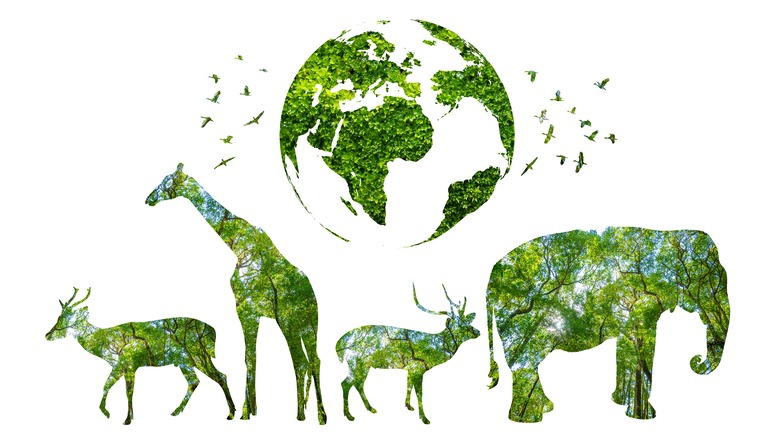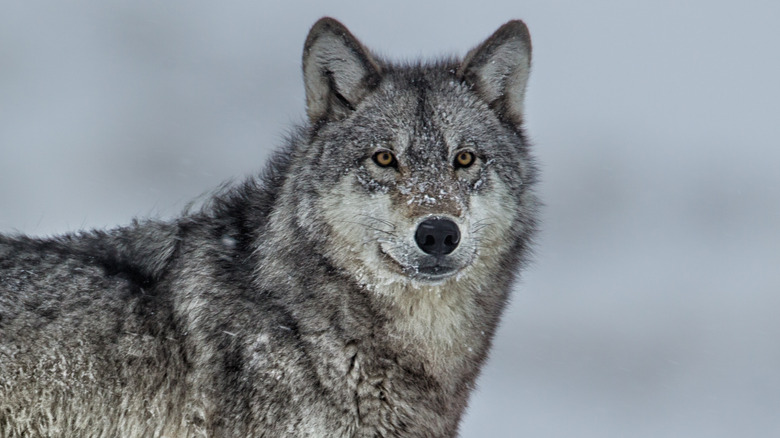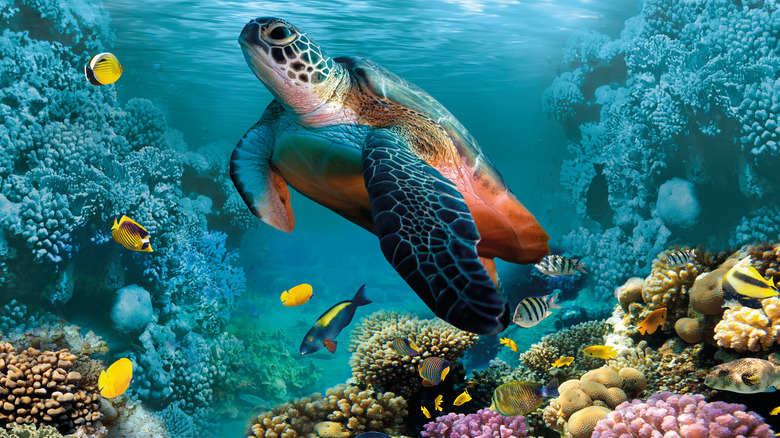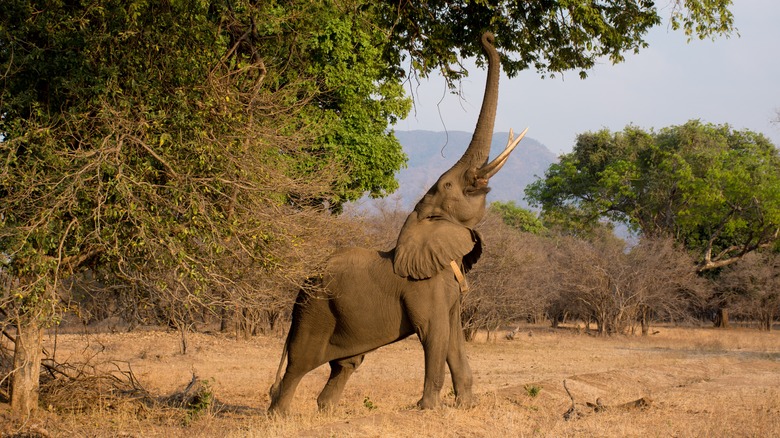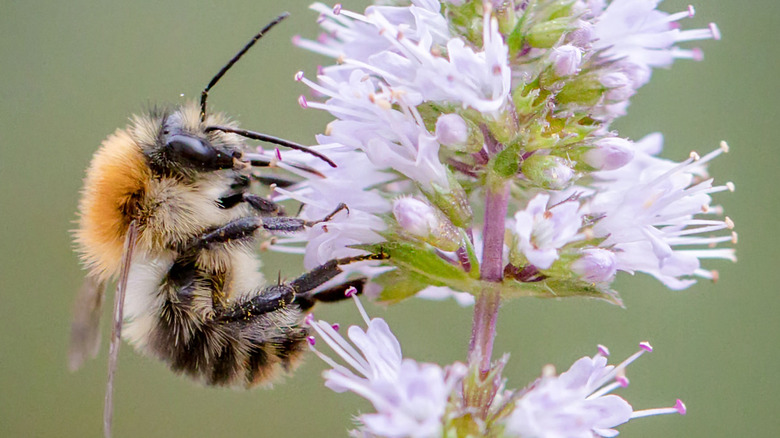What Would Happen To Humans If Animals Went Extinct?
Everything has a purpose here on Earth, and everything in each ecosystem is intertwined. Population changes to one animal or plant species can drastically affect the species' environment. Animal extinction is far from a new ecological phenomenon. Dinosaurs, mammoths, saber-toothed tigers, and dodo birds are all animals which went extinct centuries or even millions of years ago. This all makes animal extinction sound like a thing of the past. However, as animals die off at alarming rates, extinction will once again become commonplace.
Climate change (per the U.S. Geological Survey) encompasses not just rising temperatures, but also increases in droughts and natural disasters. This, along with habitat destruction from human development and poaching, are the main causes of animal extinction. The Council on Foreign Relations reported that an area five times the size of New York City was decimated in the Amazon rainforest just in the first six months of 2022. Animals like jaguars, sloths, frogs, river dolphins, and monkeys are only a fraction of the wildlife in this rainforest (per World Wildlife Fund).
Open Development Thailand explains that economic development to access natural resources occurs around the world without much thought into how to accomplish this more sustainably. This cuts down on wildlife habitats. Poachers – hunters without legal permission, per the BBC — also kill animals and sell their parts in illegal markets. Elephant tusks, rhino horns, and tiger skins are among the most popular products. Even Facebook has perpetuated the sale of such items (per New York Post).
Why is biodiversity important?
Animal extinction does not just mean that people will no longer be able to marvel at and enjoy all the incredible creatures that the Earth has to offer. It also means that the environment for humans will take a huge hit. Everything has a purpose in its environment. It is common knowledge that plant life is essential for things like breathable air, but animal life must also exist for humans to exist as well.
Biodiversity (per Australian Museum) refers to the variety of living things. This includes diversity of genetics, species, and ecosystems. There are over 13 million distinguishable species of plants and animals on Earth. Among the most diverse places are Australia, the Amazon rainforest in South America, and southeast Asia. Even minuscule insects and worms factor into biodiversity.
The Columbia Climate School explained the need for biodiversity through the example of the Yellowstone wolves. The wolves in Yellowstone — America's first-ever national park — were hunted nearly to the brink of extinction. As a top predator in the Yellowstone ecosystem, their absence led to increased populations of herbivores like elk. Too many elk caused too much plant grazing. Too much plant grazing caused erosion near bodies of water and loss of habitat for birds. Loss of habitat for birds caused an increase in insects like mosquitoes, a main food source for birds. It caused a chain reaction that did not change until wolves were reintroduced in 1995, thus restoring needed balance for Yellowstone.
Extinction of one species can trigger a domino effect
In 2018, Scientific Reports published a study called "Co-extinctions annihilate planetary life during extreme environmental change." This study echoed the chain reaction seen in Yellowstone after it lost too much of its wolf population. "Because all species are connected in the web of life, our paper demonstrates that even the most tolerant species ultimately succumb to extinction when the less-tolerant species on which they depend disappear," stated lead author Dr Giovanni Strona. Co-author Corey J. A. Bradshaw described this domino effect as "co-extinction." Strona and Bradshaw point toward climate change as a driving force behind 21st century extinction (via Science Daily).
What we need to remember is that though humans often become disconnected from nature as cities grow, we still rely upon nature for arable land, potable water, and breathable air. Wildlife is a source of control for these factors necessary for human life. "Co-extinction" can bring down life in an ecosystem, which includes human life.
Animals positively affect soil and plant life
A significant factor behind climate change is too much carbon dioxide in the atmosphere. This element is linked to rising temperatures. Plants absorb and store carbon dioxide from the air. However, animals (particularly mammals) interact with their environment in ways that increase the amount of carbon stored in soils and trees. Frontiers posted a study that showed a correlation between the amount of mammals in an ecosystem and the amount of carbon in the soil. More mammals correlated with more carbon in the soil. This means that more carbon is taken out of the atmosphere. How do animals affect carbon concentrations in plants? Aside from eating them, they physically move plants around just by existing. Therefore, they facilitate in carbon movements. This means that animal populations can help reduce carbon dioxide in the air.
Elephants are prime examples of the physical changes animals can make to the world other than carbon movements. Elephants in Asia and Africa spread seeds, fertilize the soil with their excrement, and even create watering holes (per Columbia Climate School). Other animals rely on plants that come from these seeds, and humans benefit from plant life controlling carbon dioxide.
As key pollinators, drops in bee populations are alarming
Bees made headlines in the 2010s, as populations of these insects around the world are declining. Though they are far from the only animal which affects plant life, they are often synonymous with pollination. They not only pollinate flowers, but also plants that bear food sources for humans. This is why the earth needs bees (per Earth.com).
Given the positive effects that animals have on the elements that humans need to survive, would humans go extinct if animals go extinct? Biologist Dr. Suzanne Sadedin of Monash University, Australia, says yes. Aside from pollination of food sources, we would lose forests and grasslands. This would bring about further climate change (plant life absorbs carbon dioxide, which is a contributor in climate change) and less rain. Dr. Sadedin says that humans are causing "a mass extinction that's expected to wipe out 30-50% of species in the next century." This would not give humans enough time to salvage resources in order to survive. What's worse, she believes that humans are apathetic to this extinction (per Huff Post). Not enough people care to invest in the future health of the earth by making changes to how we interact with our environment.
Environmental laws have taken hits around the world
There are at least some people who care. For example, governments around the world banned whaling starting in the 1960s. Since then, humpback whale populations are making promising comebacks (per USA Today). However, not all government administrations are keen to enact laws for wildlife protection. CNBC reported that from 2016 to 2020, the United States federal government "made it easier to remove protections on threatened animals and plants, and allowed federal agencies to conduct economic assessments when deciding whether to protect a species from matters like construction projects in critical habitats." Meanwhile in Brazil, the government has weakened the enforcement of environmental laws and made environmental budget cuts (per Council on Foreign Relations).
In a nutshell, economic gain is egregiously being held at a higher importance than keeping the Earth habitable for present and future generations. Conservationist Jane Goodall asks, "How come the most intellectual creature to ever walk Earth is destroying its only home?" However, according to The Guardian, she is holding onto hope and encourages everyone to use the knowledge we now have about sustainability and to use the technology that is continuously being developed to reduce human impact on wildlife. Such technology exists. We just have to use it.
